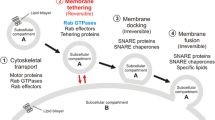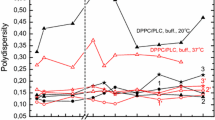Summary
The purpose of the work presented in this paper was to determine experimentally the actual mechanism of lipid bilayer conductivity in the presence of tetrachlorotrifluoromethylbenzimidazole (TTFB). The capacitance and conductance of lipid bilayers were measured with a current-clamp method, as a function of equal TTFB concentrations (10−7 to 5×10−5 m) in the two aqueous phases. The voltage across the membrane was measured as a function of time during rectangular current pulses. If the hydrogen buffer capacity of the solution is low, the voltage response to long current pulses has two components. The slow component is due to hydrogen ion concentration changes in the unstirred layers. This component disappears if the buffer capacity is made high enough. Membrane capacitance and conductance can be determined from the fast component of the voltage response. The conductance increases with the square of TTFB concentration (pH 2 to 7) and the capacitance is 0.4 μF/cm2 for the range of concentration used. If solutions of low buffer capacity are used, shifts of hydrogen ion concentrations near the membrane give rise to a complicated dependence of the membrane potential on pH given a unit pH difference between the two aqueous solutions (protonic potential). This dependence can be explained if the membrane permeability for neutral uncoupler molecules (TH) is high enough. The membrane permeability coefficient is determined:P TH=10 cm/sec. In other experiments the dependence of short-circuit current on pH difference between the two solutions was also measured, with the pH value on one side fixed in a given experiment. These complicated nonmonotonic dependences can be described using a mathematical equation with only two parameters: (1) the dissociation constant of TTFB in water (pK=5.2), and (2) the proportionality factor between short-circuit current and TTFB concentration squared. These data can be formally interpreted to mean that the membrane is permeable only to T2H− and TH, where T is TTFB anion and H is hydrogen ion. However, this model does not explain the high current values obtained because of the limited rate constant of T2H− formation in aqueous solution. An alternative model is proposed. It is shown that the T2H− is not formed in aqueous phase but rather within the membrane. The T2H− can be the intramembrane charge carrier if its life-time is long enough. If the average life-time is short, current might be carried through the membrane by proton exchange between TH and T−, when they collide. This mechanism could also account for the action of uncouplers of oxidative phosphorylation other than TTFB.
Similar content being viewed by others
References
Ermishkin, L. N., Muskhelishvili, N. L. 1971. Permeability of phospholipid membranes in the presence of uncouplers.Biofizika 16:849
Finkelstein, A. 1970. Weak-acid uncouplers of oxidative phosphorylation. Mechanism of actin on thin lipid membranes.Biochim. Biophys. Acta 205:1
Lea, E. J. A., Croghan, P. C. 1969. The effect of 2,4-dinitrophenol on the properties of thin lipid films.J. Membrane Biol. 1:225
Le Blanc, O. 1971. The effect of uncouplers of oxidative phosphorylation on lipid bilayer membranes: Carbonylcyanidem-chlorophenylhydrazone.J. Membrane Biol. 4:227
Liberman, E. A., Babakov, A. V. 1968. Diminishing characteristics and impedance of phospholipid membranes in the presence of tetrachlorotrifluoromethylbenzimidazole.Biofizika 13:362
Liberman, E. A., Topaly, V. P. 1968. Selective transport of ions through bimolecular phospholipid membranes.Biochim. Biophys. Acta 163:125
Markin, V. S., Pastushenko, V. F., Krishtalik, L. I., Liberman, E. A., Topaly, V. P. 1969. Membrane potential and short circuit current on artificial phospholipid membranes in the presence of uncouplers of oxidative phosphorylation.Biofizika 14:462
McLaughlin, S. 1972. The mechanism of action of DNP on phospholipid bilayer membranes.J. Membrane Biol. 9:361
Author information
Authors and Affiliations
Rights and permissions
About this article
Cite this article
Borisova, M.P., Ermishkin, L.N., Liberman, E.A. et al. Mechanism of conductivity of bimolecular lipid membranes in the presence of tetrachlorotrifluoromethylbenzimidazole. J. Membrain Biol. 18, 243–261 (1974). https://doi.org/10.1007/BF01870115
Received:
Revised:
Issue Date:
DOI: https://doi.org/10.1007/BF01870115




